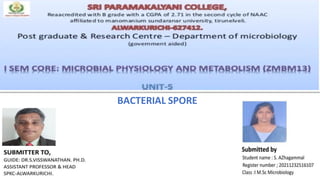
Bacterial spore physiology.pdf
- 2. Synopsis •Definition •Spore-forming bacteria •Structure •Shape and position •Exospore •Endospore •Sporulation •Reference
- 3. Definition • It is a unicellular structure. • Spores form a life cycle in many plants, algae, bacteria, fungi and protozoa. • Spores are formed during unfavorable conditions. • They can survive without nutrients. • It forms highly resistant structure.
- 4. • Bacterial spores are small oval or spherical structures that are very resistant to high temperatures, radiation, desiccation, and chemical agents. • When they are formed intracellularly, they are called endospore. • The bacterial cell producing spore is called vegetative cell.
- 5. Spore-forming bacteria Bacillus: Bacillus anthracis Bacillus subtilis Bacillus cereus Bacillus clausii Bacillus halodenitrificans Clostridium: Clostridium botulinum, Clostridium difficile, Clostridium perfringens Thermophilic actinomycetes: Thermoactinomyces vulgaris
- 6. structure
- 7. • The outer and inner coat made up of protein and they provides chemical and enzymatic resistance to the spores. • Cortex region lies between the region of outer and inner coat and it is made up of peptidoglycon. • Cortex helps in dehydration process during sporulation process and thus providing high temperature resistance.
- 8. Shape and position Shape • Spherical, oval or elongated in shape • May be narrower or broader(bulge) than parent cell
- 9. Position • Terminal (located at one of the poles) • Sub terminal or sub central(between center & one of poles • Equatorial (central)
- 10. Bacteria can be classified based on the shape and position of spores.
- 11. Bacterial spores undergoes two types of formation :
- 12. Endospore; • Formed inside the parent vegetative cell. • Endospores are highly durable dehydrated cells, which can survive extreme heat, lack of water, freezing and exposure to many toxic chemicals and radiation. • Endospores also called as “resting cells”.
- 13. Exospore; • Formed outside the vegetative cell by budding at one end of the cell. • The Exospore do not contain dipicolinic acid. • They can resist desiccation and heat.
- 15. Exospores development • exospores formation spores developed outside the body. • They developed attached with a outer surface of the cell wall. • During the unfavorable conditions Primarily, the mother cell and the daughter cells are divided by means of the septum and later it forms a bud like structure at the outer covering.
- 17. Endospore formation in some Epulopiscium-like symbionts follows a daily cycle: A) Polar septa are formed at the poles of the cell. B) Forespores become engulfed. C) Forespores gradually increase in size within the mother cell through the day. D) In late afternoon, final preparations for endospore dormancy. E) Endospores mature and remain dormant throughout most of the night. F) Just before sunrise, the endospores germinate and are released from mother cell to repeat the cycle.
- 19. Sporulation Stage I: Axial filament formation stage • In this stage bacterial chromosome become thread like known as axial filament. • Axial filaments attached to cytoplasmic membrane by mesosome. • Elongation of cell take places. • PHBA is the reserved food material in Bacillus spp is utilized in sporulation.
- 21. Stage Il: forespore formation • Asymmetric cell division occurs • Cell membrane forms septum near one end which encloses a small portion of DNA forming forespore Stage Ill: engulfment of forespore • Mother cell membrane grow around the forespore engulfing it. • Fore spore now has two membrane layer.
- 22. Stage IV: synthesis of exosporium • Chromosome of mother cell disintegrates. • Exosporium synthesis occurs. • Forespore starts Forming primodial cortex between two membrane. • Dehydration of cell. Stage V: synthesis of dipicolonic acid • Production of SASPs and dipicolinic acid occurs. • Incorporation of calcium ions with dipicolonic acid occur forming calcium dipicolonate. • Further dehydration of cytoplasm. • Formation of coat layer.
- 23. Stage VI: maturation • Maturation of endospore Stage VII: release of endospore • Cell lysis and release of endospore
- 24. Reference • Brun, Y. & Shimkets, L. J. Prokaryotic Development (ASM Press, 2000). • Sneath, P. H. Longevity of micro-organisms. Nature 195, 643–646 (1962). • "Microsporidia (Protozoa): A Handbook of Biology and Research Techniques". Archived from the original on 26 June 2008. Retrieved 8 July 2007.. modares.ac.ir • Johansson, Lönnell, Sundberg and Hylander (2014) Release thresholds for moss spores: the importance of turbulence and sporophyte length. Journal of Ecology, n/a-n/a.